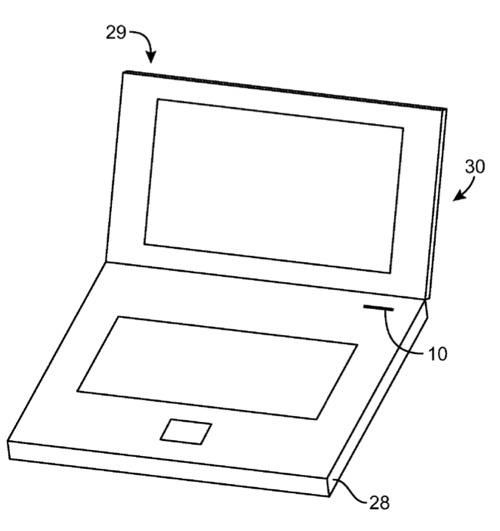A new Apple patent (number 8044873) for antennas with periodic shunt inductors has appeared at the US Patent & Trademark Office. It’s for a cellular antenna that could be used in future laptops and iPhones.
Per the patent, an antenna may be formed from conductive regions that define a gap that is bridged by shunt inductors. The inductors may have equal inductances and may be located equidistant from each other to form a scatter-type antenna structure. The inductors may also have unequal inductances and may be located along the length of the gap with unequal inductor-to-inductor spacings, thereby creating a decreasing shunt inductance at increasing distances from a feed for the antenna.
This type of antenna structure functions as a horn-type antenna. One or more scatter-type antenna structures may be cascaded to form a multiband antenna. Antenna gaps may be formed in conductive device housings. The inventors are Bing Chiang, Gregory Spring, Douglas Kough, Enrique Ayala and Matthew McDonald.
Here’s Apple’s background and summary of the invention: “Antennas are widely used in modern electronic devices. For example, antennas are often used in portable electronic devices such as laptop computers and cellular telephones. Particularly in environments such as these, there is a premium placed on small size and high radiation efficiency. Antennas that are compact take up less space in a portable device than bulkier antennas, which allows a designer to enhance the portability of a device. Highly efficient antennas reduce the amount of battery drain that is imposed on a portable device.
“It is sometimes desirable for an antenna to cover multiple frequency bands. This allows antenna hardware to be shared among multiple radio-frequency transceivers without providing too much antenna hardware in a device. Multiband antenna designs generally require antenna resonating structures that radiate over a wide range of frequencies or multiple radiators. It would therefore be desirable to be able to provide antennas that cover one or more communications band without consuming too much space in an electronic device such as a portable electronic device.
“Antennas may be provided for electronic devices. The electronic devices may be portable electronic devices such as laptop computers. The antennas may have conductive regions that form positive and negative antenna poles. The poles may be separated by a dielectric-filled gap. For example, the poles may be planar strips or regions of metal or metal alloy that are separated by a gap of air several microns in width. The conductive regions that form the antenna poles may be part of a conductive housing for an electronic device. Because the gap is small, the gap may be invisible to the naked eye, allowing the antenna to be formed on an exterior housing surface.
“Shunt inductors may bridge the antenna gap at various locations along the length of the antenna. The shunt inductors may be provided in the form of surface-mount devices (SMD). The antenna may be fed using positive and negative antenna feed terminals. The shunt inductors may have equal inductances and may be located equidistant from each other to form a scatter-type antenna structure. The inductors may also have unequal inductances and/or may be located along the length of the gap with unequal inductor-to-inductor spacings, thereby creating a decreasing shunt inductance at increasing distances from the antenna feed terminals. This type of antenna structure functions as a horn-type antenna.
“One or more scatter-type antenna structures may be cascaded to form a multiband antenna. A horn-type antenna structure may also be cascaded to add to the multiband nature of the antenna. Hybrid antennas may be thus formed from one or more scatter-type antenna structures and a horn-type antenna structure.”
— Dennis Sellers



